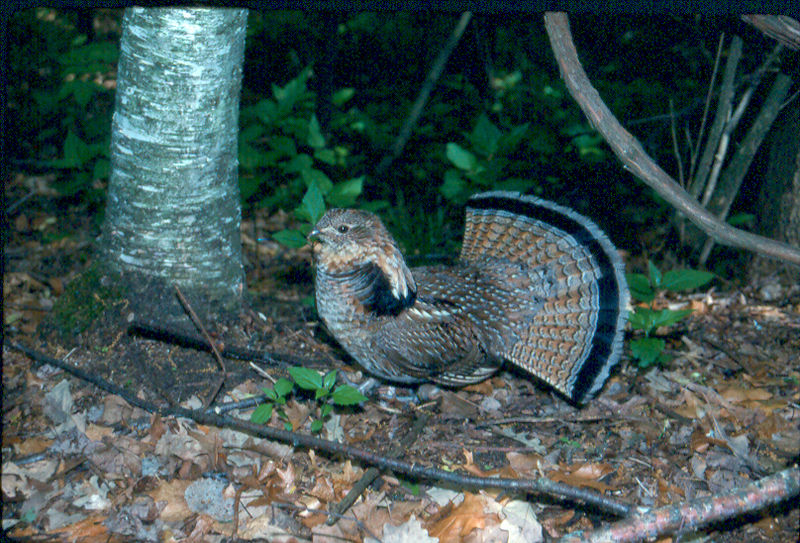It’s that time of year again when, on a walk along a quiet road or perhaps through a preserve or back woodlot, you may begin regularly hearing the distant sound of a small engine starting up. But wait a minute, you may think to yourself, there are no houses in that direction where someone would be starting an engine. And besides, the type of engine that would make that kind of sound would most likely now be only found in a museum! The sound is a low, muffled “thump” followed by another then another, the speed of the “thumps” increasing faster and faster until finally they end with a rapid whirr.
That is the welcome spring sound of a displaying male ruffed grouse. It is often described as “drumming” but it is quite unlike the “drumming” of woodpeckers when they vibrate their bills against a hollow tree. For hundreds of years, no one knew exactly how the ruffed grouse drumming sound was produced. Watching a displaying male would reveal that the bird would stand up in an open space, often on top of a downed tree or small rise on the forest floor, and snap the wings forward faster than could be perceived clearly with the human eye. The question was whether the bird was striking something—the ground, its body, its wings together—or not. It would take the advent of high-speed photography to solve the mystery once and for all. The sound is made, not by the wings striking anything at all, but by being thrown forward and retracted so rapidly that they effectively make a sudden vacuum in the air, causing the “thump” sound.
Not only is the sound and its manner of production quite remarkable, so is the reason for it. Ruffed grouse are among the relative minority of bird species that have a polygymous, rather than monogamous, mating system. In the case of the ruffed grouse, individual males attract females with their drumming sound and display. Each male maintains a small territory that is defended from other male grouse, but in some areas with good habitat, it is not uncommon to find a number of males close enough together that they could hear each other. This situation is sometimes referred to as an “exploded lek.” Some people may remember watching a nature show in which the lekking behavior of some exotic tropical species or perhaps one of the prairie-chicken species from the western U.S. is putting on a show. In those situations, the males are all relatively close together displaying for females on the perimeter or mixed in among the males, deciding on a male with whom they will eventually mate. As the name suggests, an exploded lek is a situation in which the males are a bit further away from each other, but the females still move between them and make their decisions based on their assessments of the displaying males.
Once a female comes in closer to a particular male, he will abandon the loud drumming display and begin more intimate displays involving spreading his tail and puffing out the feathers on the sides of the neck. If the female must decide that he is the one that she will mate. If he is not “the one,” she will move on and take a look and listen to some other males. Once they have mated, the female leaves and the male has no further interaction with her or the chicks that he has genetically fathered.
So, you don’t have to watch a TV show to see amazing and exotic wild animal behavioral displays and quirky mating systems right here in Maine. Just step outside and go for a walk with your ears tuned in to the low sound of what you might have thought was distant neighbor’s tractor!
Jeffrey V. Wells, Ph.D., is a Fellow of the Cornell Lab of Ornithology. Dr. Wells is one of the nation's leading bird experts and conservation biologists and author of the “Birder’s Conservation Handbook.” His grandfather, the late John Chase, was a columnist for the Boothbay Register for many years. Allison Childs Wells, formerly of the Cornell Lab of Ornithology, is a senior director at the Natural Resources Council of Maine, a nonprofit membership organization working statewide to protect the nature of Maine. Both are widely published natural history writers and are the authors of the book, “Maine’s Favorite Birds.”
































.png)
.png)
